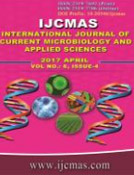


 National Academy of Agricultural Sciences (NAAS)
National Academy of Agricultural Sciences (NAAS)

|
PRINT ISSN : 2319-7692
Online ISSN : 2319-7706 Issues : 12 per year Publisher : Excellent Publishers Email : editorijcmas@gmail.com / submit@ijcmas.com Editor-in-chief: Dr.M.Prakash Index Copernicus ICV 2018: 95.39 NAAS RATING 2020: 5.38 |
Ashwagandha (Withania somnifera (L.) Dunal) is a potent medicinal plant originated in the Indian sub continent and is used in traditional systems of medicine globally. Pure lines form an important genetic resource for improvement of yield and quality. In the present study, a set of 327 (DWS1-DWS327) pure lines were developed from JA134 out crossed population through individual plant selection, selfing and generation advancement for the first time in Ashwagandha. Variation for qualitative and quantitative traits was observed between pure lines and lines with distinct morphological traits were obtained. Heritability and genetic divergence among a set of 48 pure lines with JA134 and JA30 was assessed based on 20 root yield and its component traits. We used Mahalanobis D2 statistics for the genetic divergence estimation. The accessions were grouped in to ten clusters, where cluster I was the largest containing 12 accessions, followed by cluster III consisting of ten accessions. Root yield per plant (15.1%) contributed maximum towards genetic diversity. Based on the inter cluster distance and per se performance, the pure lines DWS84 and DWS85 were selected which could be intercrossed to obtain high heterosis and also to recover transgressive segregants for the improvement of root yield and its quality. Pure lines developed in the present study form important genetic resources for the improvement of yield and quality of Ashwagandha.
 |
 |
 |
 |
 |